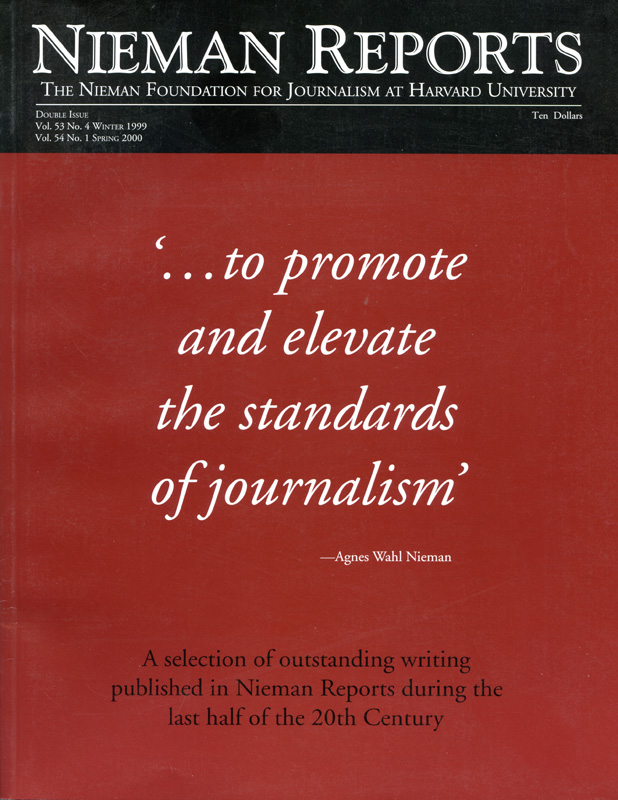
Commemorative Double Issue
What you [see] here is a collection which reflects the substance of the first 53 years of the conversation journalists have engaged in about their rights and responsibilities in the pages of Nieman Reports. At times you will find an article that opened a new argument or ended an old one. Throughout you will hear the voices of journalists committed to their work challenging colleagues to raise the standards of discovering, reporting, writing and editing the news in a context meaningful for navigation within a free society. – Bill Kovach
From early in the magazine’s history, America’s dilemma—race relations and, in this case, how journalists report stories involving race—has been dissected and debated. Regarded initially in Nieman Reports from the perspective of two Southern newspaper editors, Hodding Carter (NF’40) and Harry S. Ashmore (NF’42), race and its intersection with journalism has since taken us from courtrooms to schoolrooms from newsrooms to neighborhoods. Read more
Simeon Booker (NF’51) described what is was like to be one of 12 black newsmen to go to rural Mississippi in the mid-1950’s to report on a trial in which two white men were charged with murdering a black youth, Emmett Till. He told how white and black writers became embroiled in the trial they covered. Read more
By 1962, the civil rights movement emerged as a significant news story. John Herbers (NF’61), based in Jackson, Mississippi, with UPI, provided the magazine’s readers with an insider’s look at obstacles to news reporting. “Everyone is emotionally involved,” Herbers observed. “Persons who never before paid attention to news coverage have suddenly become experts on how the delicate subject should be handled.” Read more
Philip E. Meyer (NF’67) melded social science methods with journalistic speed and techniques to piece together newspaper coverage of problems that underlay the Detroit riot in 1967. As Meyer observed, “Reporters need to start going into the ghetto on a regular basis, and a social science-oriented survey can help map out the strange and unfamiliar terrain for them.” Read more
J. Anthony Lukas (NF’69) devoted years to reporting on the lives and decisions of three Boston families in the midst of the racial tensions brought on by court-ordered busing. In a 1978 seminar with Nieman Fellows, he explained his reasons for moving his journalism in this direction. “If we regard ourselves as covering the real politics of this country, the real politics of this country certainly include the politics of class and race in cities like Boston…. I’ve covered Watergate for The New York Times Magazine. I have covered some presidential politics and a good deal of domestic turmoil and the racial turmoil of the 1960’s, and I can tell you that nothing in my professional life have I found as compelling as what I’ve been doing in these past few years.” Read more
Robert Maynard (NF’66) turned his reporter’s eye on the newsroom to ask, what happens when the managerial ranks of newspapers remain “purer white than Ivory Snow”? The heart of the matter, he wrote, is “the ‘unseen environment’ of nonwhite America. It is the question of portrayal—rather nonportrayal or misportrayal.” Read more
Simeon Booker (NF’51) described what is was like to be one of 12 black newsmen to go to rural Mississippi in the mid-1950’s to report on a trial in which two white men were charged with murdering a black youth, Emmett Till. He told how white and black writers became embroiled in the trial they covered. Read more
By 1962, the civil rights movement emerged as a significant news story. John Herbers (NF’61), based in Jackson, Mississippi, with UPI, provided the magazine’s readers with an insider’s look at obstacles to news reporting. “Everyone is emotionally involved,” Herbers observed. “Persons who never before paid attention to news coverage have suddenly become experts on how the delicate subject should be handled.” Read more
Philip E. Meyer (NF’67) melded social science methods with journalistic speed and techniques to piece together newspaper coverage of problems that underlay the Detroit riot in 1967. As Meyer observed, “Reporters need to start going into the ghetto on a regular basis, and a social science-oriented survey can help map out the strange and unfamiliar terrain for them.” Read more
J. Anthony Lukas (NF’69) devoted years to reporting on the lives and decisions of three Boston families in the midst of the racial tensions brought on by court-ordered busing. In a 1978 seminar with Nieman Fellows, he explained his reasons for moving his journalism in this direction. “If we regard ourselves as covering the real politics of this country, the real politics of this country certainly include the politics of class and race in cities like Boston…. I’ve covered Watergate for The New York Times Magazine. I have covered some presidential politics and a good deal of domestic turmoil and the racial turmoil of the 1960’s, and I can tell you that nothing in my professional life have I found as compelling as what I’ve been doing in these past few years.” Read more
Robert Maynard (NF’66) turned his reporter’s eye on the newsroom to ask, what happens when the managerial ranks of newspapers remain “purer white than Ivory Snow”? The heart of the matter, he wrote, is “the ‘unseen environment’ of nonwhite America. It is the question of portrayal—rather nonportrayal or misportrayal.” Read more


